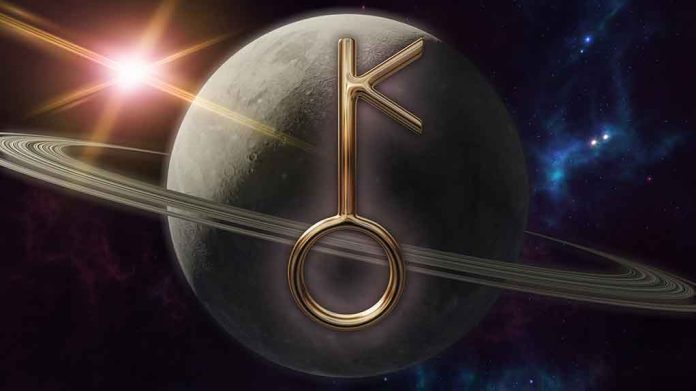
If you read your daily horoscope here on Astrovibe, you’ve seen mention of Chiron when the Moon bobs and weaves her way in and out of aspect with him. While Chiron isn’t a planet, the use of Chiron in the practice of psychological astrology has grown tremendously from the 1990s through today. Weaving his way into the mainstream, Chiron’s astrological journey has been as erratic and soul-crunching as his path around the Sun.
What IS Chiron?
Chiron was discovered in 1977, and was the first body in our solar system that was defined astronomically as a centaur. A centaur isn’t a planet, an asteroid, or a comet, yet has characteristics of two or more of these things. Chiron was first classified as asteroid 2060, but then it was discovered that he has a core like that of a comet. He has an eccentric elliptical 50.65 Earth-year path around the Sun, crossing through Saturn’s orbit and coming just inside the orbit of Uranus. The trip around the Sun is so erratic, in fact, that it may take up to seven years for Chiron to go through some signs, while only taking two to four years in others. Sometimes Chiron gets a coma, which is a cloud or ring made of ice and gas that can surround comets, depending on where he is in his orbit cycle.
Chiron is referred to as a minor or dwarf planet by some scientists, other times as a centaur or comet. The common consensus has changed a few times over the last 45 or so years, and will probably change again as we learn more about Chiron and other centaurs. It may be important to note that Chiron is only about half the size of Pluto, and we know astronomers are still arguing about Pluto’s designation.
Discovering Chiron in Astrology
In 1990, astrologer Melanie Reinhart took the astrological world by storm with her pioneering book called “Chiron and the Healing Journey.” The data and research she collected to create this ground-breaking contemporary astrological work truly changed the way astrologers used Chiron in their research and practice. It smashed open new doors for study on other dwarf planets, asteroids, and other smaller bodies in our solar system. Her insights into Chiron as an astrological archetype also helped bring a depth, breadth and renewed feeling of excitement to psychological astrology. Since then, many other astrologers have written works on Chiron and other small, yet intrinsically important, celestial bodies.
Chiron’s meaning, like all astrological symbology, comes from his mythological archetype. Archetypes are symbols in myth and literature to display some facet of human nature. Astrology also uses archetypes, especially in psychological astrology, to understand human nature through what early psychologist Carl Jung would call the collective consciousness. The philosophy brings forth the idea that in each of us is an innate understanding and embodiment of all human archetypes, and that the literature, myths, and gods created in antiquity are all living within us as part of our personality, potential, and subconscious.
The Chiron Archetype
In the most common tellings of the myth, Chiron is much like an actual centaur. Rather than half man, half horse, though, he was half demi-god and half horse. Centaurs are usually a human head and torso connected to the body and four legs of a horse. Chiron was a full man in the front with two human legs, but with the hindquarters of a horse behind him.
He was born from the nymph Philyra. His father was the Greek god Kronos. Philyra didn’t like Kronos, but he was obsessed with her. She changed into a mare to try to evade his affection. He figured out what she had done, so he changed himself into a stallion to be able to force himself on her. Chiron was born as a result of this violence.
Philyra was disgusted with Chiron and refused to be the mom of the “monster” created by this non-consensual union. She begged the gods to turn her into a tree and abandoned Chiron. This was Chiron’s first unhealable wound.
Chiron is found by the god of enlightenment, Apollo. Apollo and Artemis raise Chiron as their own and give him the very best education. Chiron becomes a healer, a teacher, an artist and scholar. As a brilliant doctor and philosopher, Chiron was also often also regarded as a sage and prophet as well. Mortals, heroes and gods would all come to Chiron for advice, training in warfare and hunting, and, of course, for healing. Hercules, Achilles, Jason, and others were all students or patients of Chiron’s.
Fun fact: Chiron is portrayed as “Phil” in the Disney version of Hercules. In the actual myth, Chiron does help Hercules learn to become a hero, but he was nothing like his Danny Devito persona in the cartoon. The myth is quite a bit darker than the comedic cartoon.
In the original stories, Hercules gets into a fight with some mortal centaurs one day and one of his wayward poisoned arrows hits Chiron. That poison was made from the venom of a hydra. It would have killed a man, beast, or centaur, but Chiron was an immortal demi-god. Due to the venom, the excruciatingly painful wound will never heal, but Chiron also could not die.
Chiron did all he could to heal himself for many years. Despite his vast medical understanding, he continued on in agony. Unlike many tragedies of old, all of the things that happened to Chiron were out of his own control and not of his own making. Chiron suffered blamelessly. Yet, through his pain, the myths say he continued on. He invented the science of medicine, surgery, and he healed the blind. At least one rendition of his myth gives him a daughter to raise as well.
There are a few varied stories about his eventual demise and the release from his pain, but the most common was that Prometheus was in trouble and had been sentenced to death. Chiron was given the opportunity to change places with him, giving up his life and allowing Prometheus to have his immortality in exchange. Chiron finally met his death by saving another’s life and found a release from his wounds, being placed among the stars for eternity.
These stories together form the archetype of the Wounded Healer. This means that wherever Chiron is in your chart is where you have your deepest wound that doesn’t heal, at no fault of your own. It is also the place in which you can be of the greatest service. It is a place of great pain, but also a place for growth and the ability to use your pain and wisdom to help someone else.
Chiron in the Natal Chart
The sign Chiron is in at your birth will describe the type of trauma or wound you might be dealing with, while the house it sits in will show you where in your life it may appear. Aspects to Chiron in the natal chart may show a connection to different areas of life where the wound may show up, either as a challenge or an opportunity. Transits (the real-time planetary aspects to natal planets and points) to Chiron may reflect either painful triggers or opportunities for healing, growth, or helping.
Chiron was discovered at a time in human history when we began to change the way we looked at trauma, which is often the way astrology works. Our understanding of human nature, and of astrology itself, expands as the human condition does. These things deftly go hand-in-hand, as they always mirror and reflect one another. For nearly a millennium, society leaned towards blaming individuals for their own pain, whether mental or physical. From “ugly laws” to the stigma and concept of sin, society simply was not kind (and sometimes, still isn’t) to those enduring unhealable wounds. As we grow to be more inclusive and gain a deeper understanding of medicine and mental health, the discovery of Chiron adds a new way for us to explore ourselves. When we heal ourselves, we help heal the world.
Some people use Chiron for something called shadow work, while other people use it as part of a larger therapy-based plan for healing. Chiron also reminds us that where we hurt can show us where we also may do the most good in this life. When we know ourselves, we can face our own pain. When we can face our own pain, we can let go of self-blame and we no longer have to hold it close to our chests or have a stake in competition with anyone else. Instead, we can blossom, heal, and grow.
Copyright 2024 Astrovibe.com


















